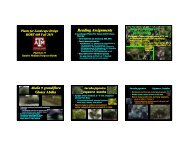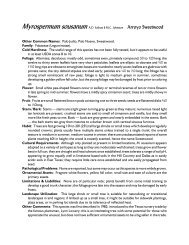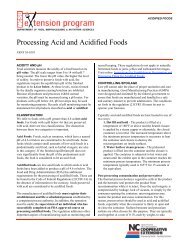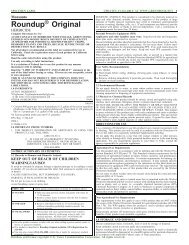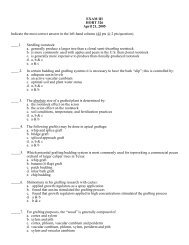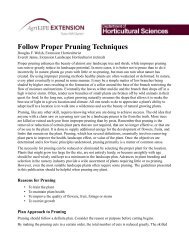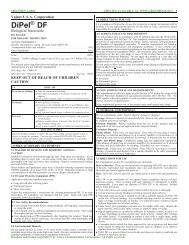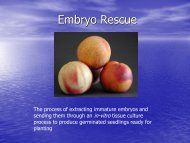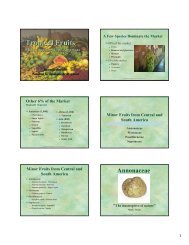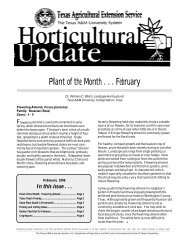Guide to PAS 2050 How to assess the carbon ... - Aggie Horticulture
Guide to PAS 2050 How to assess the carbon ... - Aggie Horticulture
Guide to PAS 2050 How to assess the carbon ... - Aggie Horticulture
You also want an ePaper? Increase the reach of your titles
YUMPU automatically turns print PDFs into web optimized ePapers that Google loves.
16<br />
Section II: Calculating product <strong>carbon</strong> footprints<br />
over a defined time period, recognising variations in<br />
geography, distance and materials.<br />
In order <strong>to</strong> comply with <strong>the</strong> requirements of <strong>PAS</strong> <strong>2050</strong>,<br />
data quality should be judged according <strong>to</strong> <strong>the</strong> rules<br />
described in <strong>PAS</strong> <strong>2050</strong> Section 7.2.<br />
• <strong>How</strong> specific is it <strong>to</strong> <strong>the</strong> declared reporting period?<br />
(Ideally <strong>the</strong> data would cover <strong>the</strong> exact time period)<br />
• <strong>How</strong> specific is it <strong>to</strong> <strong>the</strong> product’s relevant geography?<br />
• <strong>How</strong> specific is it <strong>to</strong> <strong>the</strong> product’s relevant<br />
technologies and processes?<br />
• <strong>How</strong> accurate is <strong>the</strong> information used (e.g. data,<br />
models and assumptions)?<br />
• <strong>How</strong> precise is <strong>the</strong> information? i.e. measure <strong>the</strong><br />
variability of <strong>the</strong> data values (see Step 5: Checking<br />
uncertainty)<br />
• <strong>How</strong> complete is it? i.e. is <strong>the</strong> sample size sufficiently<br />
large and representative of all potential sub-categories<br />
of <strong>the</strong> product? What percent of <strong>the</strong> data used<br />
was actually measured vs. taken from a general<br />
database?<br />
• <strong>How</strong> consistent is it?<br />
• <strong>How</strong> reproducible is it? i.e. what is <strong>the</strong> extent <strong>to</strong><br />
which an independent practitioner could reproduce<br />
<strong>the</strong> results?<br />
• What sources are used?<br />
These rules are subjective; however, <strong>the</strong>ir application<br />
will allow companies <strong>to</strong> identify <strong>the</strong> most appropriate<br />
data for <strong>the</strong>ir circumstances.<br />
Data types<br />
Two types of data are necessary <strong>to</strong> calculate a <strong>carbon</strong><br />
footprint: activity data and emission fac<strong>to</strong>rs. Activity<br />
data refers <strong>to</strong> all <strong>the</strong> material and energy amounts<br />
involved in <strong>the</strong> product’s life cycle (material inputs and<br />
outputs, energy used, transport, etc.) – see below.<br />
Emission fac<strong>to</strong>rs provide <strong>the</strong> link that converts <strong>the</strong>se<br />
quantities in<strong>to</strong> <strong>the</strong> resulting GHG emissions: <strong>the</strong> amount<br />
of greenhouse gases emitted per ‘unit’ of activity data<br />
(e.g. kg GHGs per kg input or per kWh energy used).<br />
Activity data and emissions fac<strong>to</strong>rs can come from<br />
ei<strong>the</strong>r primary or secondary sources:<br />
• Primary data refers <strong>to</strong> direct measurements made<br />
internally or by someone else in <strong>the</strong> supply chain<br />
about <strong>the</strong> specific product’s life cycle<br />
• Secondary data refers <strong>to</strong> external measurements<br />
that are not specific <strong>to</strong> <strong>the</strong> product, but ra<strong>the</strong>r<br />
represent an average or general measurement of<br />
similar processes or materials (e.g. industry reports<br />
or aggregated data from a trade association)<br />
Inputs/outputs Energy used Direct gas<br />
emissions<br />
Distribution/<br />
transport<br />
] Type and quantity<br />
] of all inputs and<br />
] outputs<br />
] For each process<br />
] step:<br />
] – Material inputs<br />
] – Product output<br />
] – Co-products<br />
] – Waste<br />
] Type, source and<br />
] quantity of all<br />
] energy used:<br />
] – Electricity<br />
] – O<strong>the</strong>r fuels<br />
] Type and quantity<br />
] of direct GHG<br />
] emissions<br />
] Vehicle type,<br />
] average distance<br />
] for all transport<br />
] legs<br />
] % full or shared<br />
] with o<strong>the</strong>r<br />
] products<br />
] % full on return<br />
] journey (backhaul)<br />
Per unit of finished product<br />
Common activity data




